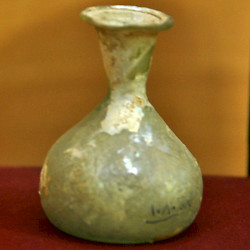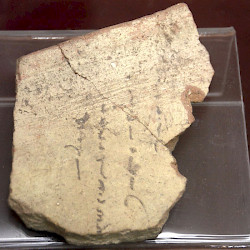Ecbatana (2)
Ecbatana (Old Persian Hagmatana, "gathering place"): main settlement of the Medes, modern Hamadan.

There are few texts about the Median and Achaemenid periods in Ecbatana. Texts about the Seleucid or Parthian age are even rarer. We know that the Macedonian king Alexander the Great, and his Successors Antigonus and Seleucus took away precious metal from the town, which was renamed Epiphaneia, probably after the Seleucid king Antiochus IV Epiphanes, who may have died in this city.note

It is also certain that the city was a royal residence again during the Parthian age,note which is logical because the Arsacid kings usually moved along the Silk Road from their eastern residences at Nisa and Hecatompylos to their western residence, Ctesiphon. It was inevitable that towns along the road, like Rhagae and Ecbatana, were resting places.
The Parthian period is the occupation phase that is archaeologically best understood. On a hill in the northern part of the city, a terrace wall of about nine meter high, a modest underground aqueduct, and houses with incredibly heavy walls have been excavated, and in the southern part of the city, a cemetery was found. Research continues.

The first excavators were French - their trench is a landmark - but in 1995, Iranian archaeologists have renewed research of the hill. Their job will not be easy. A case in point is the living quarter. The houses were as large as 17½ x 17½ meters and the streets were on a gridiron plan. It is hard to interpret these structures. For normal houses, the walls are too heavy; it has been argued that they are in fact barracks, but this is just a hypothesis. For the time being, we simply do not know what it is.
Finding the Median capital will be a giant breakthrough and is certainly possible, but so far, only the Parthian level has been identified on the northern hill. There is no reason to assume that the Achaemenid palace described by the Greek historian Polybius of Megalopolisnote must have been on the same site, nor is there proof that the Median town was identical to the Achaemenid palace city. In 2007, it was argued that the Median and Achaemenid settlements may have been somewhere else - but they cannot be too far away, as some Achaemenid artefacts have been found on the northern hill.

Among the other sights in Hamadan that may date back to Antiquity is the little mausoleum of Esther and Mordecai, the Jewish wife of the Achaemenid king Xerxes and her uncle. Although the sanctuary, the only national monument of the Jews in modern Iran, is very old indeed (it is already mentioned by Benjamin of Tudela in the twelfth century), the cult is probably medieval, not ancient, and has nothing to do with the Parthian royal tombs, maintained by Jews, that the Jewish historian Flavius Josephus mentions in Ecbatana.note The inscription mentions that the mother of two eleventh-century physicians erected the cenotaphs.

One final monument is the famous "lion of Hamadan". According to a local legend, rubbing this monument with oil will make a bride fertile. It has been argued that this ancient statue belongs to the funeral monument of Hephaestion, the lover of Alexander the Great. This is certainly not the case, as Hephaestion was cremated in Babylon, where the remains of his funeral pyre have been identified, and all the remains in the neighborhood of Hamadan's lion belong to a Parthian cemetery. Stilistically, however, the "lion of Hamadan" may be Hellenistic.
 Hamadan, Parthian oil lamp |
 Hamadan, Sasanian flask |
 Hamadan, Sasanian dish |
 Hamadan, Sasanian ostracon about receiving a ration of food |